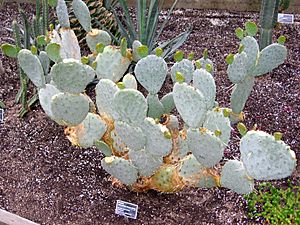Opuntia macrorhiza facts for kids
Quick facts for kids Opuntia macrorhiza |
|
|---|---|
 |
|
| Scientific classification | |
| Genus: |
Opuntia
|
| Species: |
macrorhiza
|
| Synonyms | |
|
Synonymy
Opuntia compressa var. macrorhiza (Engelm.) L.D. Benson
Opuntia cymochila Engelm. & J.M. Bigelow Opuntia mackensenii Rose Opuntia mesacantha var. cymochila (Engelm. & J.M. Bigelow) J.M. Coult. Opuntia mesacantha var. macrorhiza (Engelm.) J.M. Coult. Opuntia rafinesquei f. cymochila (Engelm. & J.M. Bigelow) Schelle Opuntia tortispina Engelm. & J.M. Bigelow Opuntia tortispina var. cymochila (Engelm. & J.M. Bigelow) Backeb. Opuntia ballii Rose Opuntia delicata Rose Opuntia filipendula Engelm. Opuntia pottsii Salm-Dyck Opuntia setispina Engelm. ex Salm-Dyck Opuntia tenuispina Engelm. & J.M. Bigelow |
|
Opuntia macrorhiza is a type of cactus often called the plains prickly pear or twistspine pricklypear. It's a common plant found in many parts of the United States and northern Mexico. You can spot it growing across the Great Plains, from Texas all the way up to Minnesota. It also grows in the desert and Rocky Mountains areas, from Arizona to Idaho. Sometimes, you can even find it in the Mississippi and Ohio Valleys. In Mexico, it's found in states like Chihuahua and Sonora. People sometimes grow this cactus in their gardens because it's pretty!
What Does It Look Like?
This cactus loves dry, sandy, or rocky ground. It's one of the shorter types of prickly pear cacti. It usually grows less than 30 cm (about 1 foot) tall. However, it spreads out wide, forming large groups or clumps on the ground.
Flowers and Fruits
The flowers of the plains prickly pear are very bright and showy. They are usually a sunny yellow color. Sometimes, you might see a bit of red near the bottom of the petals.
After the flowers bloom, the cactus produces fruits. These fruits are long and narrow. They turn red when they are ripe. The fruits are juicy and safe to eat.
Different Kinds of Plains Prickly Pear
Scientists have suggested that there might be several different types, or "varieties," of Opuntia macrorhiza. However, they are still studying these differences. More research is needed to decide if these types should be considered separate species. It's also possible they are just slight variations of the same plant.
See also
 In Spanish: Opuntia macrorhiza para niños
In Spanish: Opuntia macrorhiza para niños

